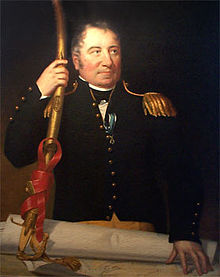John Stricker
| John Stricker | |
|---|---|

Brigadier General John Stricker, painted in 1816 by Rembrandt Peale, (1778-1860), at request of Mayor and City Council of Baltimore as a set of important military/civil leaders during recent Battle of Baltimore to be honored by being displayed in municipal offices. Peale also painted George Washington and Thomas Jefferson among others of American Revolutionary War-era and owned/operated a historic and natural history museum in Baltimore.
|
|
| Born |
February 15, 1759 Frederick, Maryland |
| Died | June 23, 1825 (aged 66) Baltimore, Maryland |
| Place of burial | Westminster Hall and Burying Ground, in Baltimore, Maryland, (formerly the Western Burying Grounds for the First Presbyterian Church, later surmounted by the Westminster Presbyterian Church, at southeast corner of North Greene and West Fayette Streets) |
| Allegiance |
|
| Service/branch |
Maryland State Militia, Continental Army (American Revolutionary War) |
| Years of service | 1775–1783, 1812–1815 |
| Rank | Brigadier General (United States) |
| Commands held | Third Brigade ("City Brigade" or "Baltimore Brigade"), Third Division, Maryland State Militia |
| Battles/wars | |
American Revolutionary War, War of 1812,
Brigadier General John Stricker (1758–1825) was a Maryland state militia officer who fought in both the American Revolutionary War in the First Maryland Regiment of the famous "Maryland Line" of the Continental Army and in the War of 1812. He commanded the Third Brigade (also known as the "City Brigade" or the "Baltimore Brigade") of the Maryland state militia in the Battle of North Point on Monday, September 12th, 1814, (later known as "Defenders' Day, a state, county and city holiday) which formed a part of the larger Battle of Baltimore, along with the subsequent British naval bombardment of Fort McHenry on September 13-14th, and was a turning point in the later months of the War of 1812 and to the peace negotiators across the Atlantic Ocean for the Treaty of Ghent, in the city of Ghent then in the Austrian Netherlands, (now of future Belgium), which finally arrived at a peace treaty on Christmas Eve of December 1814, of which news finally reached America in February 1815.
Stricker was born on February 15, 1759, at Frederick, Maryland in Frederick County. He was the son of Colonel George Stricker, who served during the Revolutionary War. The younger Stricker served as a cadet under his father's command, in the 1st Maryland Regiment, commanded by Gen. William Smallwood. He was present at the Battles of Princeton (January 3, 1777) in New Jersey, Brandywine (September 11, 1777), in Pennsylvania, and Monmouth (June 28, 1778), (also New Jersey - last battle of the Revolutionary War in the Northern Theatre).
...
Wikipedia
